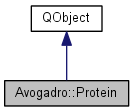Representation of a protein, including secondary structure. More...
#include <avogadro/protein.h>

Public Member Functions | |
| Protein (Molecule *molecule) | |
| virtual | ~Protein () |
Chains | |
| const QVector< QVector < Residue * > > & | chains () const |
| int | numChains () const |
| QList< unsigned long > | chainAtoms (int index) const |
| QList< unsigned long > | chainResidues (int index) const |
Secondary structure | |
| QByteArray | secondaryStructure () const |
| bool | isHelix (Residue *residue) const |
| bool | isSheet (Residue *residue) const |
Detailed Description
Representation of a protein, including secondary structure.
The Protein class helps other parts of the library or plugins to work with proteins. If the molecule was read from a pdb file, an attempt will be made to get the secondary structure information from the HELIX and SHEET lines. If this fails, a simplified version of the DSSP algorithm is used.
http://en.wikipedia.org/wiki/Secondary_structure#The_DSSP_code
The secondary structure is assigned based on hydrogen bonding patterns. There are eight types of secondary structure that DSSP defines:
- G = 3-turn helix (310 helix). Min length 3 residues.
- H = 4-turn helix (α helix). Min length 4 residues.
- I = 5-turn helix (π helix). Min length 5 residues.
- T = hydrogen bonded turn (3, 4 or 5 turn)
- E = extended strand in parallel and/or anti-parallel β-sheet conformation. Min length 2 residues.
- B = residue in isolated β-bridge (single pair β-sheet hydrogen bond formation)
- S = bend (the only non-hydrogen-bond based assignment)
Amino acid residues which are not in any of the above conformations are assigned as the eighth type '-' = Coil. The helices (G,H and I) and sheet conformations are all required to have a reasonable length. This means that 2 adjacent residues in the primary structure must form the same hydrogen bonding pattern. If the helix or sheet hydrogen bonding pattern is too short they are designated as T or B, respectively.
Constructor & Destructor Documentation
| Avogadro::Protein::Protein | ( | Molecule * | molecule | ) |
Constructor.
- Parameters:
-
molecule The object parent.
| Avogadro::Protein::~Protein | ( | ) | [virtual] |
Destructor.
Member Function Documentation
| QList< unsigned long > Avogadro::Protein::chainAtoms | ( | int | index | ) | const |
- Returns:
- All atom ids for chain with
index.
References QList::append(), and Avogadro::Fragment::atoms().
| QList< unsigned long > Avogadro::Protein::chainResidues | ( | int | index | ) | const |
- Returns:
- All residue ids for chain with
index.
References QList::append(), and Avogadro::Primitive::id().
| const QVector< QVector< Residue * > > & Avogadro::Protein::chains | ( | ) | const |
- Returns:
- All the residues in the protein ordered by chain.
| bool Avogadro::Protein::isHelix | ( | Residue * | residue | ) | const |
- Returns:
- True if the residue is part of a sheet.
References Avogadro::Primitive::index().
| bool Avogadro::Protein::isSheet | ( | Residue * | residue | ) | const |
- Returns:
- True if the residue is part of a sheet.
References Avogadro::Primitive::index().
| int Avogadro::Protein::numChains | ( | ) | const |
- Returns:
- the number of chains in this protein
- Returns:
- QByteArray with codes for the protein's secondary structure.
The documentation for this class was generated from the following files:
- /home/kitware/dashboards/avogadro/libavogadro/src/protein.h
- /home/kitware/dashboards/avogadro/libavogadro/src/protein.cpp
 1.8.0
1.8.0